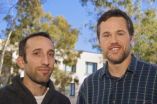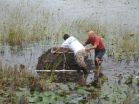(Press-News.org) (Santa Barbara, Calif.) –– For decades, consensus among psychologists has held that a group of five personality traits –– or slight variations of these five –– are a universal feature of human psychology. However, a study by anthropologists at UC Santa Barbara raises doubt about the veracity of that five-factor model (FFM) of personality structure as it relates to indigenous populations. Their findings appear in the current issue of the American Psychological Association's Journal of Personality and Social Psychology.
Studying the Tsimane, an isolated indigenous group in central Bolivia, Michael Gurven, a professor of anthropology at UCSB and lead author of the paper, found they did not necessarily exhibit the five broad dimensions of personality –– openness, conscientiousness, extraversion, agreeableness, and neuroticism. While previous research has found strong support for what experts refer to as the "Big Five" in more developed countries and across some cultures, Gurven and his team, which includes Christopher Von Rueden, a postdoctoral scholar in anthropology at UCSB and co-author of the paper, discovered more evidence of a Tsimane "Big Two" –– prosociality and industriousness. These combine elements of the traditional Big Five, and may represent unique aspects of highly social, subsistence societies.
"Similar to the conscientiousness portion of the Big Five, several traits that bundle together among the Tsimane included efficiency, perseverance, and thoroughness," said Gurven, who is also co-director of the Tsimane Health and Life History Project, a collaboration between UCSB and the University of New Mexico, with co-director and co-author Hillard Kaplan. "These traits reflect the industriousness of a society of subsistence farmers.
"However," Gurven continued, "other industrious traits included being energetic, relaxed, and helpful. In small-scale societies, individuals have fewer choices for social or sexual partners, and limited domains of opportunity for cultural success and proficiency. This may require abilities that link aspects of different traits, resulting in a trait structure other than the Big Five."
The Tsimane live in communities ranging from 30 to 500 people dispersed among approximately 90 villages. Since the mid-20th century, they have come into greater contact with the modern world, although fertility and mortality rates remain high, the study noted. With formal education available to few Tsimane, the literacy rate is below 25 percent. Some 40 percent speak Spanish in addition to their native language. They live in extended family clusters that share food and labor, and they usually limit contact with outsiders unless absolutely necessary, the authors said.
The researchers translated into the Tsimane language a standard questionnaire that assesses the Big Five personality traits, and interviewed 632 adults from 28 villages. Women comprised 48 percent of the sample, with an average age of 47 and little more than a year of formal education.
In addition, the researchers conducted a separate study to gauge the reliability of the self-report interviews by instead focusing on reports by peers. For that study, they asked 430 Tsimane adults, including 66 people from the first study, to evaluate their spouse's personality. The second study revealed that the subject's personality as reported by his or her spouse also did not fit into a Big Five framework.
The researchers controlled for education level, Spanish fluency, gender, and age. Previous research has suggested that formal schooling and greater interaction with others, such as when villagers venture to markets in other towns, can lead to more abstract reflection and may be one reason why the Big Five replicates in most places, according to the authors. However, there were no significant differences between the less educated, Tsimane-only speakers and the more educated bilingual participants.
While recent research on personality variation has demonstrated that the Big Five personality traits may be lacking in some developing cultures –– particularly in Asia and Africa –– Gurven noted that theirs is the first study of a large sample of an exclusively indigenous population completed with rigorous methodological controls. He suggested that personality researchers expand beyond the limited scope of more Western, industrialized, and educated populations.
"The lifestyle and ecology typical of hunter–gatherers and horticulturalists are the crucible that shaped much of human psychology and behavior," he said. "Despite its popularity, there is no good theory that explains why the Big Five takes the form it does, or why it is so commonly observed. Rather than just point out a case study where the Big Five fails, our goal should be to better understand the factors that shape personality more generally."
INFORMATION:
Other contributors to the article include Maxim Massenkoff of UCSB and Marino Lero Vie of San Borja, Beni, Bolivia.
'Universal' personality traits may not be universal after all
2013-01-09
ELSE PRESS RELEASES FROM THIS DATE:
Counting the twists in a helical light beam
2013-01-09
Cambridge, Mass. - January 8, 2013 - At a time when communication networks are scrambling for ways to transmit more data over limited bandwidth, a type of twisted light wave is gaining new attention. Called an optical vortex or vortex beam, this complex beam resembles a corkscrew, with waves that rotate as they travel.
Now, applied physicists at the Harvard School of Engineering and Applied Sciences (SEAS) have created a new device that enables a conventional optical detector (which would normally only measure the light's intensity) to pick up on that rotation.
The ...
New marker of drug response may speed pace of lung cancer prevention trials
2013-01-09
Testing medicines to prevent lung cancer requires treating many thousands of high-risk individuals and then waiting 5, 10 or 15 years to discover which of them develop cancer and which, if any, experience survival benefit from the treatment. A University of Colorado Cancer Center study recently published in the journal Cancer Prevention Research proposes a possible waypoint on the way to benefit, which if validated, could dramatically reduce the number of patients needed and time required to test drugs for lung cancer prevention.
"Chemoprevention is an important approach ...
Battle of the sexes: Who wins (or loses) in ACL ruptures?
2013-01-09
ROSEMONT, Ill.—Female athletes are three times more likely to suffer from anterior cruciate ligament (ACL) ruptures, one of the most common knee injuries, compared to male athletes. The ACL is one of the four main ligaments within the knee that connect the femur (upper leg bone) to the tibia (lower leg bone). Recent research highlights the unique anatomical differences in the female knee that may contribute to higher injury rates, and should be taken into consideration during reconstructive surgery and sports training, according to a review article in the January 2013 issue ...
Chemists devise inexpensive, benchtop method for marking and selecting cells
2013-01-09
LA JOLLA, CA – January 8, 2013 - Chemists at The Scripps Research Institute (TSRI) have found an easier way to perform one of the most fundamental tasks in molecular biology. Their new method allows scientists to add a marker to certain cells, so that these cells may be easily located and/or selected out from a larger cell population.
The technique, which is described in a recent issue of the chemistry journal Angewandte Chemie International Edition, makes use of the tight binding of two proteins that are cheaply obtainable but are not found in human or other mammalian ...
Pythons, lionfish and now willow invade Florida's waterways
2013-01-09
Foreign invaders such as pythons and lionfish are not the only threats to Florida's natural habitat. The native Carolina Willow is also starting to strangle portions of the St. Johns River.
Biologists at the University of Central Florida recently completed a study that shows this slender tree once used by Native Americans for medicinal purposes, may be thriving because of water-management projects initiated in the 1950s. Canals were built to control runoff and provide water for agriculture. The unintended consequence -- stable water levels -- allowed Carolina Willow ...
Obesity drops among children enrolled in NY state WIC nutrition program
2013-01-09
New York children participating in a federal nutrition program had healthier eating behaviors and lower rates of obesity two years after improvements to the program were undertaken, according to a study published online today in Obesity, the official journal of the Obesity Society.
In 2009 all 50 states rolled out sweeping changes to the menu of foods available through the Special Supplemental Nutrition Program for Women, Infants, and Children, or WIC, which reaches nearly half of all infants born in the United States. New York was the first state in the nation to roll ...
Inside DayGlo: A video tour of the world's most colorful factory
2013-01-09
A new American Chemical Society (ACS) video provides a behind-the-scenes-look at the DayGlo Color Corp. factory, producer of the fluorescent paints that light up traffic cones, black light posters, hula-hoops and other products. The video, the latest episode of the award-winning Bytesize Science series from the world's largest scientific society, is at www.BytesizeScience.com.
Inside DayGlo opens with a brief history of the company, which has been designated as an ACS National Historic Chemical Landmark, and continues with an in-depth look inside its main production ...
Testing Einstein's E=mc2 in outer space
2013-01-09
With the first explosions of atomic bombs, the world became witness to one of the most important and consequential principles in physics: Energy and mass, fundamentally speaking, are the same thing and can, in fact, be converted into each other.
This was first demonstrated by Albert Einstein's Theory of Special Relativity and famously expressed in his iconic equation, E=mc2, where E stands for energy, m for mass and c for the speed of light (squared).
Although physicists have since validated Einstein's equation in countless experiments and calculations, and many technologies ...
Researchers try new approach for simulating supernovas
2013-01-09
VIDEO:
This is a computer simulation of one octant of a core collapse supernova, using SNSPH.
Click here for more information.
Two University of Texas at Arlington researchers want to bridge the gap between what is known about exploding stars and the remnants left behind thousands of years later. So they're trying something new – using SNSPH, a complex computer code developed at Los Alamos National Laboratory.
On Tuesday, Carola I. Ellinger, a post-doctoral researcher at ...
Bottom-up approach provides first characterization of pyroelectric nanomaterials
2013-01-09
By taking a "bottom-up" approach, researchers at the University of Illinois at Urbana-Champaign have observed for the first time that "size does matter" in regards "pyroelectricity"—the current/voltage developed in response to temperature fluctuations that enables technologies such as infrared sensors, night-vision, and energy conversion units, to name a few.
"Controlling and manipulating heat for applications such as waste heat energy harvesting, integrated cooling technologies, electron emission, and related functions is an exciting field of study today," explained ...


